Customizing Your Climbing Skin Fit & Finish
Skinning in the Wasatch Mountains is a unique experience and unlike almost anywhere else in the world. First off, most approaches to the hills can be measured in minutes and/or inches, so miles of miles of kick & glide do not apply. Second, we get a lot of deep, dry snow, so trail breaking is generally a bitch. Third, between avalanche danger and the terrain, many of the skin tracks follow ridgelines, which means steeper skin tracks. Fourth, between the crystalline structure of our snow and the heavy traffic that skin tracks get, grip is usually far more important than glide. And fifth, the main attraction in the Wasatch is powder skiing, which means lots of shorter laps versus one or two big ones. All of these elements add up to a certain style of skinning, which in turn favors a certain type of skin and skin set-up.
For skis 90mm and narrower, I still prefer a full nylon skin as it climbs so well and is completely indestructible. I don’t think twice about skinning through rocks, across roads, over trees or crossing creeks with my skins on. The downside of nylon skins is that they are heavier and don’t fold down as well, so for wider skis I prefer a nylon/mohair mix as they are substantially lighter, but don’t climb as well.
Regardless of the skin type, I trim all of my skins out in the same manner, which I am the first to admit takes much longer than just buying pre-trimmed skins, but I think it is worth it both for fit and reliability. A standard day of touring in the Wasatch usually involves 4-6 skin rips & reapplies, and I’ve seldom if ever had a skin failure or even a tail-hook blow using this method.
Step One
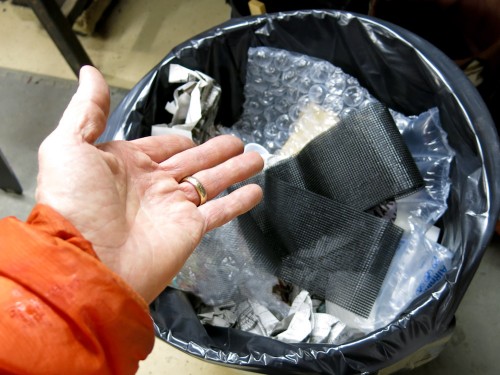
Place your skin savers in an appropriate container.
Step Two
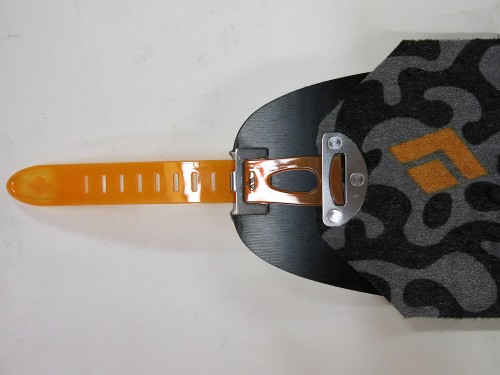
Set the tail length. Most of your skinning power/grip comes from your heels aft, so it is worth getting every inch possible out of this portion of your skins. I start with mine on the second to last position, which maximizes the skin area, but still leaves a tiny bit of adjustment in case your skins wet-out and need some extra tension.
Step Three
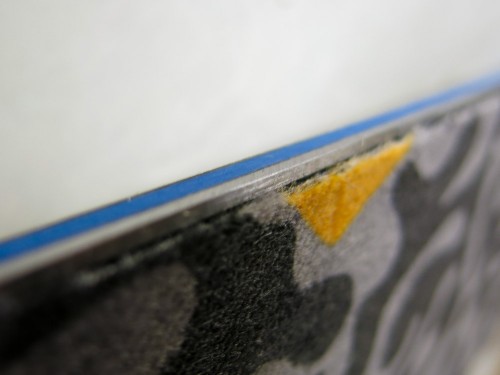
Trim out the skins with the full edge and a bit of the base showing. This gives you both a maximum amount of grip, plus sharp edges. Trimming them “neat” to the edges is way easier, but hateful when contouring on firm snow.
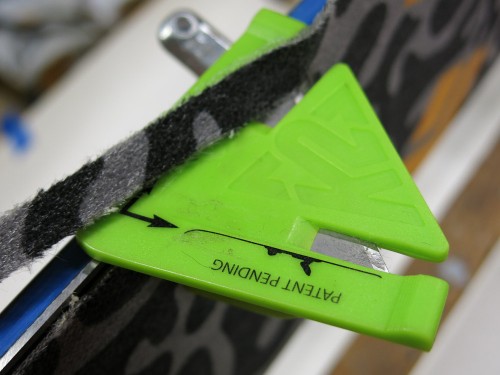
An edge trimmer like the ones made by K2 or G3 work pretty well, but have a hard time trimming very thin segments. I’ll often use a combo of one of these trimmers and a basic straight-edge razor.
Step Four
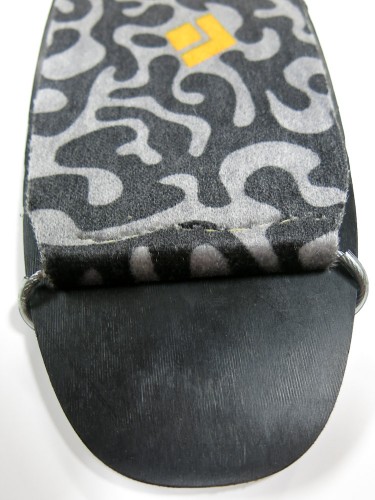
Fold the skin over a basic tip loop and stitch it down. I know – I’m an old skool ‘tard, but I really like the simplicity of a basic tip loop, they way they don’t stretch, their reliability, their weight savings and the fact this arrangement can be field maintained with a loop of cord if it ever breaks, which it never does.
On the tips, I try to make the skins as wide as possible to prevent snow from creeping under the edges, which just gets worse and worse with each lap.

I use a Speedy Stitcher to sew the tip down. A hack job is fine.
Step Five
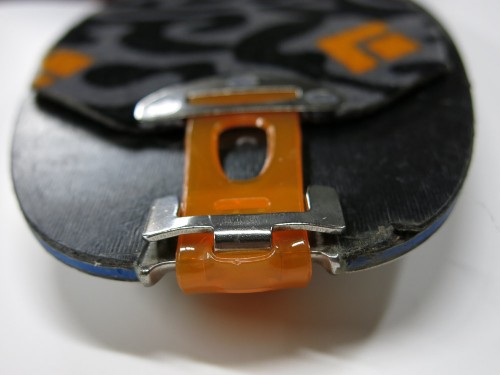
Tweak your tail clip edges by bending them down with a set of pliers. This not only creates a smoother glide profile, but it also helps keep the tail clip from getting snagged on things which might knock it loose.
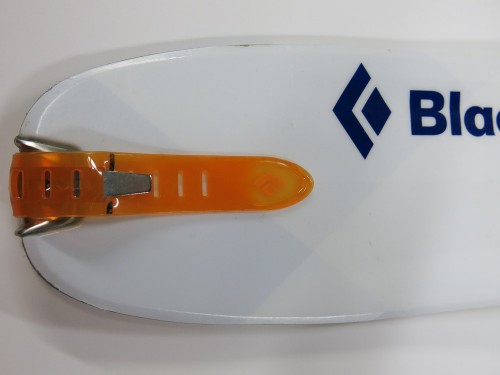
While you are at it, double your tail tension strap back. This makes it easier to grab for a skis-on deskinning and also keeps you from stepping on a dangly tail when switch-backing.
Step Six
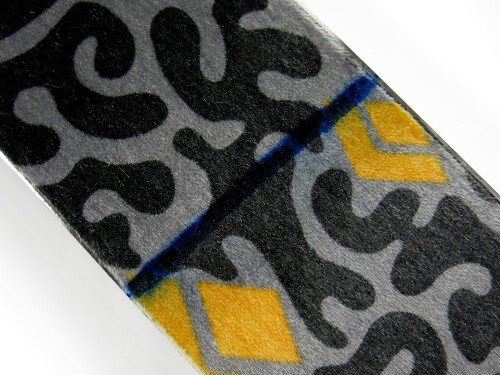
Mark the halfway point with a permanent marker. This will eventually wear off, but by then your skins will have a well established crease to them which will make them much easier to fold.
Step Seven

Rip skins thousands of times in the future and climb your brains out without any further worry or maintenance.
After a day of use, I’ll hang my skins up to dry and then later store them with their appropriate skis.
________________________________
Help support StraightChuter.com and dial in some Black Diamond Ascension Nylon STS Skins from Backcountry.com. Click on the photo below…
Category: 02 Gear, Tips & Technique, Wasatch Mountains

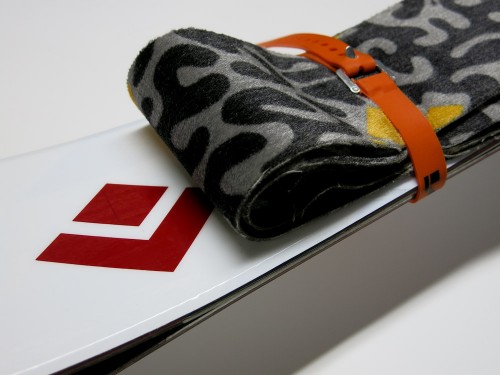
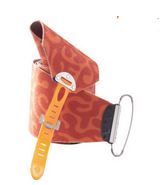








What’s your take on the appropriate amount of dog hair and pine needles to keep the skins glued to the skis while maintaining rippability?
All the skin companies love their custom cutting tools, but my all-time favorite was a set of Kohla skins that just came with a break-off blade box cutter.
why throw away the skin saver? the glue is so freaking sticky these days it can almost impossible to pull skins apart, and I think it might also damage the glue to do so. I won’t bring the skin savers for a tour but always use them for storage. thoughts?
Cameron – YGMV (Your Glue May Vary)? I’ve never had overly sticky skins, but part of that might be that I prefer nylon skins on 90mm’ish wide skis. The nylon skins tend to be beefier, which makes them easier to pull apart, and the narrow width means less contact area. Some of those really wide 140mm mohair skins have a ton of surface area and very thin backing, which makes them hard to peel.
Andy – it depends on the type of dog. ;) Now that we are without a beloved Bernese Mountain Dog, it takes quite a bit more Yellow Lab hair to achieve the same effect.
Why use skins when you can take a heli or a nice gondola? Haha, jk, hope life is sweet Andrew!
My daughter was got her first full bc set up this year, psyched! She is 10 and fired up! Hope to see you around…Sweetness of life…
um, I mean just got her first full bc set up…
Let’s face it, Andrew, most skiers are lazy when it comes to ski/skin maintenance. I know plenty that wax their skis at the beginning of the season and that’s it. Edges? P-tex? Pah! Expecting them to deal with their skin woes is absurd. But a little attention here and some of the extra sticky, shoulder destroying skin peels get easier.
As glue ages, it oxidizes and something about this process produces something evil. Being pretty OCD myself, I’ve snagged hateful skins from partners and refreshed or replaced the glue to good effect. These guys and gals usually have 2 or 3 years on the rugs and the glue is shot. Yep, they’re nearly impossible to pull apart. I’d be tempted to fish the skin savers from the trash, too. But ironing on some parchment paper and letting it cool before pulling it off seems to cook some of the oxidized crap from the glue and refreshes the surface. Alternatively, taking a layer off the old fashioned way with ironing on paper and pulling while still hot also cleans them up and removes the dog hair/pine needle mix.
Lastly, adding a strip of material or two down the center of fatties reduces the surface area to a manageable amount. Time well spent and you won’t need a shoulder scope.
Amen to putting “skin savers” in an “appropriate” container!
great article, thanks for the tips. my rear tail clip is on like third-to-last hole, sounds like an adjustment is in order.
fwiw i use the skin savers, just enough to cover half the skin; a small addition that goes unnoticed in terms of weight/volume that eliminates an annoyance.
Thanks AM, great tips here.
In response to Cameron’s question about the skin savers… Have you all heard of G3 “love gloves”? Basically a pair of large, thin nylon socks. You grab the glue side of the skin in the middle (at the mid-line Andrew told you to draw on your skins) and roll it down (to mention circumcision here seems apt).
The nylon fabric ties up the glue which eliminates pulling the skins apart so that application to the ski is a cinch. It also seems to really reduce tacky-glue syndrome as well. They are a bit expensive ($30-35) but such a simple, great idea. I bought a pair and then got another… more money than sense I guess.
For me a hot iron directly on old glue does wonders. Maybe use some of that cheap pink paper flooring underlayment from Home Depot between the iron and skin if the glue is super lumpy but pull the paper off right away as you run the (very) hot iron over it to thin the glue out a bit. After one of these paper treatments I just use the hot iron directly on the glue as needed to keep it smooth but do it outdoors or you will die early from the fumes. I’m getting at least 4 seasons of pretty heavy abuse out of one good glue job this way. Just make sure not to skip Andrew’s step 1. Never tried step 5, I like it.
i find that just putting a small amount of snow on the glue after the ripping them apart the first time makes new glue more managable…so long as you are careful to not freeze the glue entirely
Anyone know – Are “G3 Love Gloves” wide enough for skins that fit a 139 mm tip ski?
Lisa, the way you apply the love glove is from the waist and roll it down. It does not extend all the way to the tips. You fold the tips and tails of the skin back onto the love glove. A little bit Canada hokey but this video should show you: http://www.youtube.com/watch?v=AVGeME_aZC8
Thanks Lew!